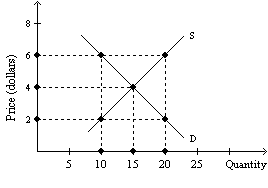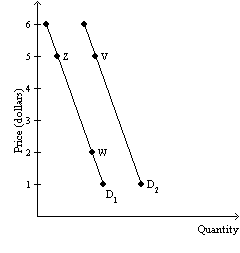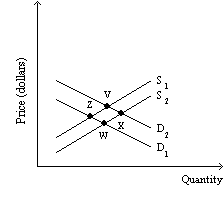A) The price will increase, but the quantity may increase or decrease.
B) The price will increase, and the quantity will increase.
C) The price will decrease, and the quantity will increase.
D) The price will stay the same, but the quantity will increase.
E) The price will stay the same, but the quantity will decrease.
Correct Answer

verified
Correct Answer
verified
Multiple Choice
Exhibit 3-4  Refer to Exhibit 3-4. A price of $4 in the market will result in
Refer to Exhibit 3-4. A price of $4 in the market will result in
A) a shortage of 10 units.
B) a surplus of 10 units.
C) a surplus of 5 units.
D) a shortage of 5 units.
E) no shortage or surplus.
Correct Answer

verified
Correct Answer
verified
Multiple Choice
If a demand curve shifts rightward, this means
A) quantity demanded is greater only at one particular price.
B) quantity demanded is lower at every price.
C) buyers are willing and able to purchase more of the good at every price.
D) buyers are willing and able to purchase less of the good at every price.
Correct Answer

verified
Correct Answer
verified
Multiple Choice
Which of the following statements is false ?
A) The shift factors for the supply curve are: income, preferences, prices of related goods, the number of buyers, and expectations of future price.
B) A change in (own) price changes the quantity supplied of a good.
C) A change in demand is graphically represented by a shift in the demand curve.
D) A change in quantity demanded is represented by a movement along a given demand curve.
Correct Answer

verified
Correct Answer
verified
Multiple Choice
A change in price will lead to a change in __________ and to a change in __________, while a change in government subsidies will lead to a change in __________ and a change in the number of buyers will lead to a change in __________.
A) quantity demanded; quantity supplied; supply; demand
B) demand; quantity supplied; supply; quantity demanded
C) quantity demanded; supply; quantity supplied; demand
D) quantity supplied; quantity demanded; demand; supply
E) quantity demanded; demand; quantity supplied; supply
Correct Answer

verified
Correct Answer
verified
Multiple Choice
At a price of $9.99 per digital book, Danielle buys 3 digital books per month. When the price decreases to $7.99, Danielle buys 4 digital books per month. Jason says that Danielle's demand for digital books has increased. Is Jason correct?
A) Yes, Jason is correct.
B) No, Jason is incorrect. Danielle's demand has decreased.
C) No, Jason is incorrect. Danielle's quantity demanded has decreased, but her demand has stayed the same.
D) No, Jason is incorrect. Danielle's quantity demanded has increased, but her demand has stayed the same.
E) No, Jason is incorrect. Danielle's quantity demanded has increased and her demand has decreased.
Correct Answer

verified
Correct Answer
verified
Multiple Choice
At a price of $15 each, Marta buys 4 books per month. When the price increases to $20, Marta buys 3 books per month. Luz says that Marta's demand for books has decreased. Is Luz correct?
A) Yes, Luz is correct.
B) No, Luz is incorrect. Marta's demand has increased.
C) No, Luz is incorrect. Marta's quantity demanded has decreased, but her demand has stayed the same.
D) No, Luz is incorrect. Marta's quantity demanded has increased, but her demand has stayed the same.
E) No, Luz is incorrect. Marta's quantity demanded has decreased and her demand has increased.
Correct Answer

verified
Correct Answer
verified
Multiple Choice
Jerry has $50,000 in his savings account and the average new car price is $23,000. Does Jerry have a demand for a new car?
A) Yes, since Jerry can afford a new car.
B) Not necessarily. Jerry has the ability to buy a new car, but we don't know if he also has the willingness to buy a new car.
C) Yes, since Jerry's savings is more than double the average new car price.
D) Yes, since Jerry probably needs a new car.
Correct Answer

verified
Correct Answer
verified
Multiple Choice
Exhibit 3-3
 Good Y
Refer to Exhibit 3-3. A movement from point Z to point W would have been the result of
Good Y
Refer to Exhibit 3-3. A movement from point Z to point W would have been the result of
A) a reduction in the price of good Y.
B) an increase in taxes paid by the producers of good Y.
C) a decline in technology in the production of good Y.
D) an increase in the number of buyers of good Y.
Correct Answer

verified
Correct Answer
verified
Multiple Choice
Exhibit 3-5  Refer to Exhibit 3-5. In the market shown, a rightward shift in supply from S1 to S2 could have been caused by
Refer to Exhibit 3-5. In the market shown, a rightward shift in supply from S1 to S2 could have been caused by
A) a decline in the number of buyers in the market.
B) a decline in the price of a substitute good.
C) a decrease in income (assuming the good is a normal good) .
D) the granting of a subsidy to the producer.
Correct Answer

verified
Correct Answer
verified
True/False
When the price of carrots falls, the quantity demanded of carrots rises, ceteris paribus.
Correct Answer

verified
Correct Answer
verified
True/False
An increase in supply is graphically represented by a leftward shift of the supply curve.
Correct Answer

verified
Correct Answer
verified
Multiple Choice
Exhibit 3-7  Refer to Exhibit 3-7. If S1 is the relevant supply curve, an increase in the price of good X may cause
Refer to Exhibit 3-7. If S1 is the relevant supply curve, an increase in the price of good X may cause
A) the supply of good X to shift from S1 to S2
B) the supply of good X to shift from S1 to S3.
C) a movement along S1 perhaps from point A to point B.
D) a movement along S1 perhaps from point A to point C.
E) no change in the quantity supplied of good X.
Correct Answer

verified
Correct Answer
verified
Multiple Choice
One major reason for the law of demand is that
A) one price changing requires at least one other price to change in the opposite direction.
B) people substitute relatively lower-priced goods for relatively higher-priced goods.
C) a higher price never reduces quantity demanded by enough to lower total revenue.
D) people are willing to produce more units at a higher price.
Correct Answer

verified
Correct Answer
verified
Multiple Choice
Exhibit 3-2
 Good X
Refer to Exhibit 3-2. Suppose equilibrium is at point A. Something then changes and equilibrium becomes point C. Which of the following is consistent with the change in equilibrium from point A to C (assuming that good X is a normal good) ?
Good X
Refer to Exhibit 3-2. Suppose equilibrium is at point A. Something then changes and equilibrium becomes point C. Which of the following is consistent with the change in equilibrium from point A to C (assuming that good X is a normal good) ?
A) There was a decrease in the number of buyers and business taxes increased.
B) There was an increase in the number of buyers and business taxes decreased.
C) There was an increase in the number of buyers and business taxes increased.
D) There was a decrease in the number of buyers and business taxes decreased.
Correct Answer

verified
Correct Answer
verified
Multiple Choice
Resource X is necessary to the production of good Y. If the price of resource X rises,
A) the supply curve of Y shifts leftward.
B) the supply curve of Y shifts rightward.
C) the supply curve of Y is unaffected.
D) there is a movement down the supply curve of Y.
E) there is a movement up the supply curve of Y.
Correct Answer

verified
Correct Answer
verified
Multiple Choice
Exhibit 3-1  Refer to Exhibit 3-1. At a price of $6 there is a
Refer to Exhibit 3-1. At a price of $6 there is a
A) surplus of 100 units.
B) surplus of 150 units.
C) surplus of 200 units.
D) shortage of 150 units.
E) shortage of 200 units.
Correct Answer

verified
Correct Answer
verified
Multiple Choice
One reason that helps to explain the law of supply is the law of
A) diminishing marginal utility.
B) diminishing marginal returns.
C) decreasing opportunity costs.
D) demand.
Correct Answer

verified
Correct Answer
verified
Multiple Choice
If the demand curve for a good shifts leftward,
A) quantity demanded is less at each price.
B) quantity demanded remains constant at each price.
C) quantity demanded is greater at each price.
D) demand is greater at each price.
Correct Answer

verified
Correct Answer
verified
Multiple Choice
A change in price will lead to a change in __________ and to a change in __________, while a change in preferences will lead to a change in __________ and a change in the prices of relevant resources will lead to a change in __________.
A) quantity supplied; demand; income; supply
B) demand; quantity supplied; supply; quantity demanded
C) quantity supplied; supply; quantity supplied; demand
D) quantity supplied; quantity demanded; demand; supply
E) quantity supplied; quantity demanded; supply; demand
Correct Answer

verified
Correct Answer
verified
Showing 41 - 60 of 224
Related Exams